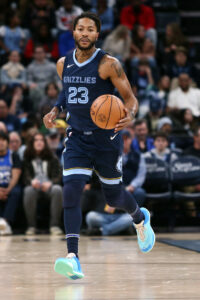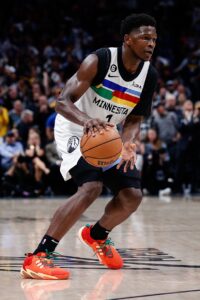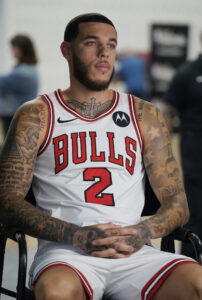When the NBA sought to incorporate an in-season tournament into its regular season schedule for the first time, the league needed to answer two important questions about the event. What would make the tournament meaningful for its players, and what would make it meaningful for fans?
The NBA addressed the first question with a fairly simple answer: money. The teams that make the knockout round of the in-season tournament will earn cash prizes, ranging from $50K per player for quarterfinalists to $500K per player for the eventual champion.
It’s not a particularly elegant solution, but it sounds like it has be an effective one. Several players have spoken in recent weeks about the very real incentive that prize money has provided.
And it’s not just young players or minimum-salary veterans that are tantalized by the prospect of a $500K bonus, which might represent a huge portion of their year-end earnings. Even well-compensated stars like Anthony Davis have cited the cash incentive as a motivator that has helped those games feel more meaningful — the Lakers‘ 4-0 record in round robin play suggests that wasn’t just talk.
Still, while the bonus money provides an incentive for the players, most fans aren’t going to celebrate the fact that the guys on their favorite teams are getting an extra pay check. The NBA still needs to ensure the event feels meaningful for the people in the stands and those watching at home.
Finding an appropriate incentive that would appeal to fans as well as to players and teams is tricky. Awarding the winner(s) an extra draft pick was one option said to be discussed, but that would arguably be a disincentive for certain players, who may not want to fight to give their team the right to draft a younger, cheaper prospect who might replace them on the roster. Giving the winner(s) an extra cap exception was a similar idea thrown out there, but that would be a tough sell for casual fans and wouldn’t necessarily benefit teams.
An automatic playoff berth or some level of home-court advantage in the playoffs makes some sense, but the NBA has suggested it wants to keep the tournament separate from its postseason. The league may also risk further devaluing the regular season by locking in a playoff spot or home-court advantage for a team based on a handful of victories in November and December — what if that team falls off a cliff in the second half and finishes with 30 wins?
Ultimately, the NBA decided not to introduce any additional incentives beyond the prize money for players, which has made it difficult for some fans to get too invested in the event in its first year.
Of course, you could argue that a team’s NBA Finals victory doesn’t provide any special incentive to fans beyond the satisfaction of seeing your favorite team succeed on the league’s biggest stage. After all, it’s not as if fans receive cash prizes when their team wins a championship.
But the postseason in the spring is the culmination of an 82-game regular season and has established its importance over the course of the league’s history. It will take some time for an in-season tournament to stake out that sort of inherent meaningfulness — if it ever happens.
We want to know what you think. In order to make the in-season tournament more successful going forward, does the NBA need to introduce some sort of incentive for teams and fans beyond the bonus money for players? Or will the satisfaction of rooting for your favorite team to win games that are perhaps more competitive than typical November and December regular season contests ultimately be enough to make the tournament feel meaningful?
Head to the comment section below to let us know your thoughts!

 The Rose rule allows a player who is finishing his rookie scale contract to sign a maximum-salary contract that exceeds the typical limit for a player with fewer than seven years of NBA experience. The rule, which was created after Rose won a Most Valuable Player award while playing on his rookie contract, allows young stars to qualify for a maximum salary worth 30% of the salary cap instead of 25%.
The Rose rule allows a player who is finishing his rookie scale contract to sign a maximum-salary contract that exceeds the typical limit for a player with fewer than seven years of NBA experience. The rule, which was created after Rose won a Most Valuable Player award while playing on his rookie contract, allows young stars to qualify for a maximum salary worth 30% of the salary cap instead of 25%. In recent years, the significant majority of rookie scale extensions that include Rose rule language have been more of a yes or no proposition — a player qualifies for the 30% max with an All-NBA spot, regardless of which team he makes.
In recent years, the significant majority of rookie scale extensions that include Rose rule language have been more of a yes or no proposition — a player qualifies for the 30% max with an All-NBA spot, regardless of which team he makes. Because those extensions won’t go into effect until at least the 2024/25 season and the NBA won’t finalize the ’24/25 salary cap until next summer, we can only ballpark what many of year’s maximum-salary contracts will look like based on the league’s latest cap estimates.
Because those extensions won’t go into effect until at least the 2024/25 season and the NBA won’t finalize the ’24/25 salary cap until next summer, we can only ballpark what many of year’s maximum-salary contracts will look like based on the league’s latest cap estimates. After missing half of the 2021/22 season and all of ’22/23, Ball still wasn’t ready to play this fall. The point guard, who has undergone multiple procedures in an attempt to address his knee problems, received a
After missing half of the 2021/22 season and all of ’22/23, Ball still wasn’t ready to play this fall. The point guard, who has undergone multiple procedures in an attempt to address his knee problems, received a  In that scenario, the player’s incoming value for the receiving team for matching purposes is determined by averaging his current-year salary and the salaries in each year of his new extension. His current team, on the other hand, simply treats his current-year salary as the outgoing figure for matching purposes.
In that scenario, the player’s incoming value for the receiving team for matching purposes is determined by averaging his current-year salary and the salaries in each year of his new extension. His current team, on the other hand, simply treats his current-year salary as the outgoing figure for matching purposes.